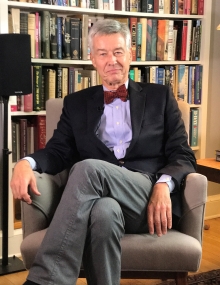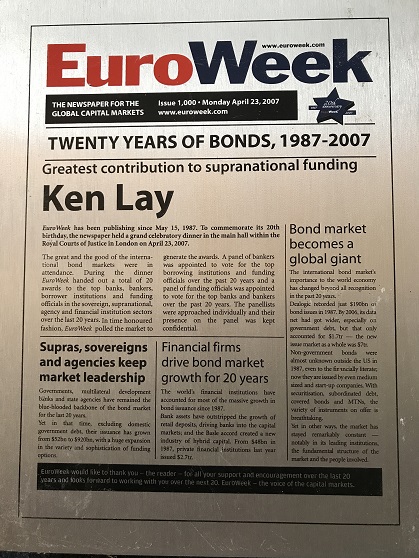On the wall in Ken Lay’s study in his home in upper N.W. DC, hangs a framed tombstone of the first Global Bond.
“Yes, it was viewed as a big deal,” says Lay, looking at the printed reminder of the historic USD 1.5bn 10-year issue launched in 1989, which made his name synonymous with the word “innovation”.
This deal did more than any other to break down barriers to capital flows and pave the way for the boom in issuance that followed in the 1990s. So much so that in 2010, as he was leaving his position as vice president and treasurer of the World Bank, where Lay has worked for 28 years, the magazine Global Capital called him “the architect of the modern bond market”.
When he finally was appointed as the Treasurer in 2006, the role of capital markets in financing strategic sectors in the developing world was much different than the one he found when joining the Bank in 1982.
“It wasn't that long ago that the institutional investment was still in its formative stages. For example, the states had legal lists of the securities that their pension funds could buy and I can recall early in my career traveling around the United States to talk to regulators and get the states to go ahead, and put World Bank bonds on their legal list alongside federal agencies,” recalls Lay.
His experience runs the gamut from advocating for removing inefficiencies of the market to monitoring the health of countries’ banking and capital markets to developing the concepts that now are conventional, such as global and green bonds. Lay could talk for hours about the extraordinary transformations that happened in the capital markets since the first World Bank bond was issued in 1947. But when Gene Rotberg, then Treasurer, asked Lay to join the World Bank in the early ‘80s, his response was “I don’t know finance.”
The future “architect of the modern bond market” honestly did not think he qualified to work at the Treasury.
“It surprises me when I think about the fact that I ended up working at the World Bank,” said Lay with a smile when we caught up with him recently at his home.
His major at Dartmouth College had nothing to do with finance or economics. Instead it was English Medieval History. For graduate school he chose to follow in his father’s footsteps and go to law school. Lay received his JD from George Washington University and started working at the U.S. Securities and Exchange Commission. That’s where Rotberg recruited this young, brilliant mind who eventually pioneered the global bonds.



